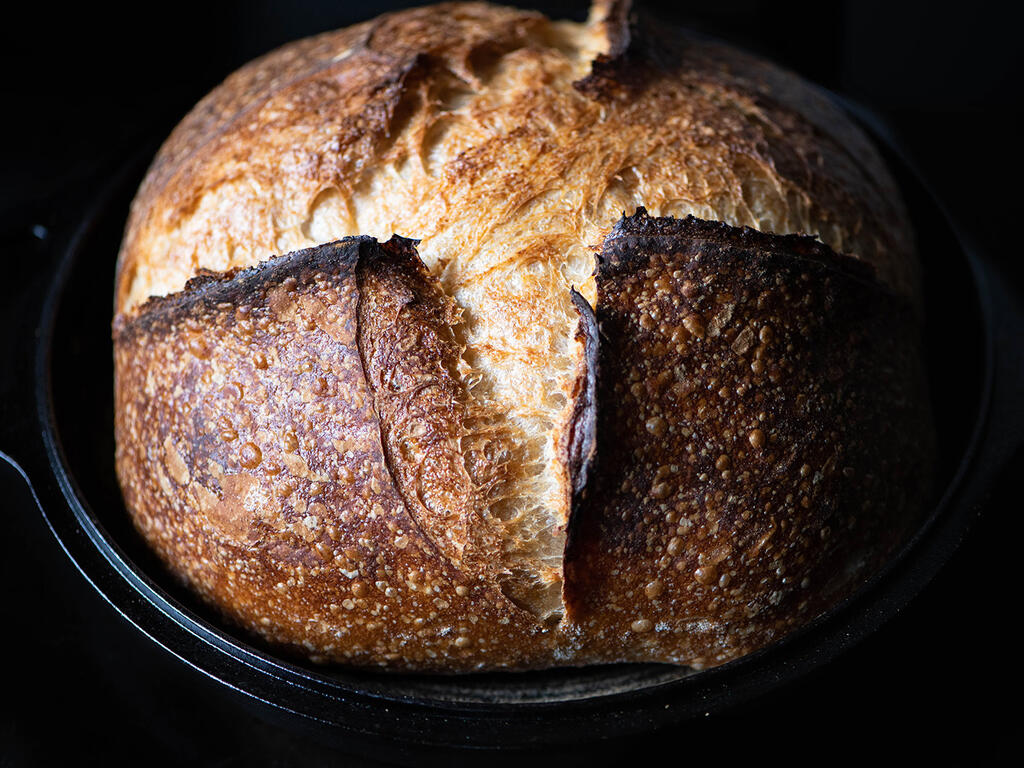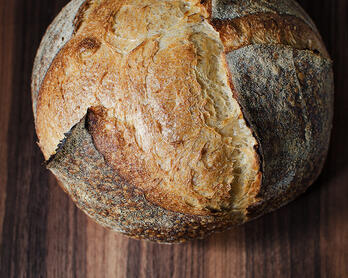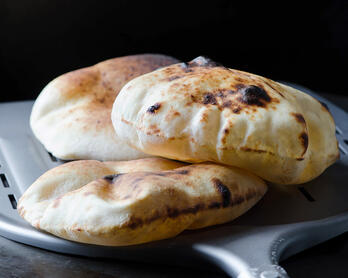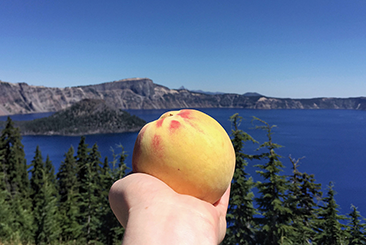Where to Buy Local Flour (and Why)

POST UPDATED 4/16/24
Newsletter
Sign up at the bottom of this page for the free Chic Eats newsletter. It includes new recipes along with a grab bag of curated content that was interesting enough to share around the dinner table.
Whole Grains
With the move to industrial mills and refined wheat around 1900, flour shifted from being a flavor component to simply being a vehicle for flavor. It became a blank canvas rather than an ingredient worthy of consideration.
I often beat the drum that quality whole grains make food taste better. The nutrition is important, no doubt, but it's the aroma and depth of flavor that changed the way I cook. When I swap some whole grain flour into a 100% all-purpose recipe, it never fails to make me pause and appreciate how much more satisfying and delicious the results are.
As Roxana Jullapat writes in her cookbook, Mother Grains:
To date, I haven’t encountered a recipe that doesn’t benefit from the addition of whole-grain flour. From pasta and bread, to pies and doughnuts, even a small amount can make a difference in flavor and texture.
For the purposes of this article, "whole grains" primarily refers to flour varieties such as Sonora, Spelt, Red Fife, Buckwheat, Einkorn, Rouge de Bourdeux, Wit Wolkoring, Star Hard White - there are many more. Honorary mentions to Floriani Red Flint Cornmeal, Appalachian Blue Cornmeal, and others in the corn family. A diversity of grains that are bred, grown, and milled in a way that preserves their nutty, buttery, and unique qualities. It’s a symphony for the nose and palate when you marry those characteristics with other ingredients. These grains and flours also broaden what is planted in fields around the country, focusing more energy and resources on local and regional economies.
This brings me to the point of this post - Where to Buy Local Flour (and Why). I was curious about what whole grain products were available in the United States and ended up poking around the Internet in search of regional growers and millers. One thing led to another and I found myself down a rabbit hole of cookbooks, grain alliances, medical journals, and history lessons. The information was piling up in my brain like a plate of spaghetti and needed a home so here we are - this resource list was born.
What struck me as I looked through old publications is how the conversations we are having today - specifically about processed wheat - echo concerns from a century ago. An example is "Our Wheaten Flour and Breakfast Foods" in the 1913 issue of Good Housekeeping. Written by the "Father of the FDA", Dr. Harvey Wiley, the article described in detail how whole wheat compared to the "snowy flour" in the grocery aisles and advocated for the former.
It would be a great blessing...if the consuming public could be supplied direct from the mills with the simple, genuine, products of whole grain, but this can be accomplished only when there is so general a demand for such goods as to compel the purveyors to furnish them. - Dr. Harvey Wiley
Whether you're expanding or just discovering your joy of whole grains, there will hopefully be something of value below. The post includes a list of whole grain resources by region and state, some quick whole wheat baking tips, cookbooks, and some of my favorite recipes that work with a variety of grains.
"Take your pleasure [and flour] seriously." - Charles Eames
Beautiful as a Red Tomato
Before we get to the local flour list, let’s take a stroll…
I (like many folks) grew up seeing two kinds of flour on the grocery shelf - industrially produced white all-purpose and “whole wheat”, the latter being a lone bag on the bottom shelf. Whole grain products were tucked off in a corner or could only be found in small health stores that smelled strongly of vitamins. What constitutes a “whole grain” product is a different issue altogether.
What happened to the nutty, earthy, and buttery aroma and flavor of quality whole grains? One similair tale is the tomato.
For the last 50 years give or take, grocery store tomatoes have been bred and engineered to be productive on the vine, pest resistant, shelf stable, and able to withstand long hauls. There are upsides to such a magnificent fruit being able to reach more people, but domestication for retail meant flavor was lost.
[Scientific] analysis revealed a rare form of a gene that imparts tomato flavor to the fruit is missing in most modern, domesticated tomatoes. Yet, more than 90 percent of wild tomatoes have the flavor-punching version of the gene." - Discover, 2019
And what about nutrition?
Fruits and vegetables grown decades ago were much richer in vitamins and minerals than the varieties most of us get today. The main culprit in this disturbing nutritional trend is soil depletion: Modern intensive agricultural methods have stripped increasing amounts of nutrients from the soil in which the food we eat grows. - Scientific American, 2011
Thankfully, consumer awareness and passionate growers are helping tomatoes reemerge as the star that they are rather than an obligatory extra on the plate. A similar story can be told for flour.
Once Upon a Time
Before the advent of industrial agriculture, Americans enjoyed a wide range of regional flours milled from equally diverse wheat, which in turn could be used to make breads that were astonishingly flavorful and nutritious...As wheat spread from the coasts inward, so did flour mills. By 1840, 23,000 of them were scattered throughout the country. (Today there are around 200.) - New York Times, Bread is Broken
What is industrial agriculture?
This is a high level take that doesn't get into transportation improvements and other aspects that contributed to the transformation of whole grain.
- Milling: In the early 1900s, the processing of whole grains was consolidated in the hands a few large companies. Instead of grinding the flour whole as many regional mills had done (and humans had been doing for thousands of years), the companies used steel roller mills to split the whole grains into their respective parts - germ, bran, endosperm. The shelf stable and less nutritious bits of the grain were then conditioned, bleached, and blended in a way that made the flour consistent. This process stripped many of the nutrients out of the grain resulting in a transportable and exportable (albeit bland) product. The absence of nutrients is why companies started fortifying flour with vitamins in the 1940s.
- Farming: When mills were spread all over the country, there was more diversity in terms of what farmers were growing from region to region. Industrial roller mills meant farmers were pushed to grow wheat that was, "even more amenable to the new dominant technologies; whiteness, hardness and uniformity took precedence over flavor, nutrition and novelty." - New York Times, Bread is Broken
Industrialization and consolidation of wheat growing, milling, and distribution all but erased diversity and quality whole grains from our collective awareness. Sameness isn’t a good thing and the Cavendish banana (the one most widely sold) would like to elaborate. The Gros Michel will second the Cavendish from The Great Beyond.
Not Everyone Rolled With It
It was apparent to some in the early 1900s that the consequences of stripping whole grains not only resulted a less satisfying food product, it was also detrimental to public health. From Dr. Wiley to correspondence in a 1924 British Medical Journal, a number of medical professionals at the time suggested that losing whole grain flour had long-term negative consequences. Unfortunately, it was an uphill battle for wheat advocates, a battle that was ultimately won by lobbyists and large corporations. Consumers enjoyed the convenience of refined wheat so flour as flavor became a memory.
The nutritional issues are complex and have been extensively covered by others who are deeper in the subject than I am. I encourage anyone who is curious to ask The Google about refined flour and inflammation, cholesterol, fiber intake, diabetes, cardiovascular disease, and vitamins. There are additional relevant topics and plenty of articles out there.
We're Still Friends, AP
With all of the above said, I'm not a purist. Sifting or bolting flour to make it "whiter" is not a new concept as of 1900 but industrial milling's homogenization of grain took things to an unhealthy extreme.
While whole grains occupy a bigger part of my pantry than white flour, Central Milling's Beehive All-Purpose and ABC have their place and won't be getting kicked out of the house. Moderation is my approach.
And now, on to cooking and sourcing.
2 Quick Tips for Baking with Whole Grains
- Substitute 20-30% whole grain in whatever you're making and don't worry about tweaking the recipe. This approach has never failed me. I often increase the whole grain % in subsequent bakes, and if the recipe gets a bit dry a teaspoon or so of additional liquid usually does the trick.
- If you're new to buying whole grains, a straightforward question to ask is: What flours are good for structure - such as with pizza and bread - and what flours are good for pastries and muffins? There is overlap in those categories but the question is a helpful starting point. I've used Sonora, Spelt, Rouge de Bourdeaux, Wit Wolkoring, Chiddam Blanc de Mars, Star (Hard White), Red Fife, and others in a variety of baked goods with great success. If your local grower/miller has something they feel works well for a particular application, go for it. Most of these millers either have helpful information on their websites about baking with the respective whole grains or they're happy to answer questions.
Recipes for Whole Grains
We live in exciting flour times - raspberries and spelt, just about any whole grain in pancakes, buttery Edison in sourdough bread or Sicilian Pizza, and Chiddam Blanc de Mars in pie/galette dough. Here are some additional recipes that lend themselves to experimentation and are favorites of mine.
- Sourdough Pancakes - As Amy Holloran rightly states in The Pancake Papers, pancakes are the perfect vehicle for test driving fresh local flour. I have worked on my recipe for years and crave it regularly. The Pancake Papers is $1.99 for the PDF or $5 for paper - a quick and informative read plus some bonus recipes.
- Oatmeal Date Cookies - Not only does the overall flavor sing, but this Mother Grains recipe is 100% whole grain which is sensible since there's not much reason for white flour in a dessert with a casual structure.
- Overnight Sourdough Waffles - These waffles are 50% whole grain and so satisfying -- buttery yet crisp with the perfect structure to handle a healthy drizzle of syrup.
- Roasted Whole Grain Banana Bread - Even when I have made less than perfect versions of this bread on the Airstream, it's still outstanding. There is a magic interplay between bananas and whole grains.
- Last Minute Sourdough Biscuits - Similar to Sourdough Pancakes, this recipe is great with just about any grain and it's quick to pull together.
- Tartine's Pumpkin Tea Cake - For years I made this with 100% all-purpose flour and it was quite good. I eventually added whole grain and it really made a difference. The whole grains transformed the void left by 100% all-purpose flour into a beautiful partner for all the spices and roasted squash.
- Sourdough Naan/Pita - I make this regularly and use whatever whole wheat flour I have on hand. Leftovers freeze perfectly, in fact I recommend making extra to squirrel away.
Whole Grain Cookbooks
Below are a handful of my baking cookbooks that include a nice selection of recipes using whole grains.
- Heirloom
- Sourdough
- Mother Grains
- Heritage Baking
- Tartine Book No. 3
- The Violet Bakery Cookbook
- The Miller's Daughter
- Southern Ground
- The Perfect Loaf
Where To Buy Whole Grains
As already mentioned, small mills were once the foundation of local food systems in the United States. I don’t expect things will go back to those days but it would be nice if the choice wasn’t binary - either industrial flour or regional. The only way for local grain growers and millers to establish themselves is for there to be demand from the community.
Developing regional markets and crops can help growers step out of the constraints of commodity production and into crops and farm plans that are more ecologically diverse, and hopefully, more economically resilient. - Amy Holloran, Author of The New Bread Basket
The excellent news is that there has been a resurgence in local milling. I am grateful to have discovered miller Nan Kohler and her company Grist & Toll. The flour she produces fundamentally changed how I think of whole grains as an ingredient. Grist & Toll and all of the businesses listed below are critical pivot points in the food supply chain when it comes to giving whole grains a much needed seat at the table. Please support them.
List Housekeeping
Needle in a Wheatstack
In terms of assembling the list, I spent time sifting through grain alliance websites, magazine articles, and cookbooks to find reputable sources for whole grain. My hope is to keep refining and adding to this list since there aren't that many comprehensive resources for this information. If you know of a great business that isn't represented here, please let me know in the comments or via email. Several readers have already helped enhance the list and a miller reached out to thank me for sales they made through Chic Eats referrals. Let's keep that energy flowing.
Legend
- ** - I have purchased flour or wheat berries from them.
- pick-up - A good local resource but shipping may not be available. Online ordering may be available.
- wheat berries - You will need a home mill to buy their product.
Regional & State-by-State Whole Grain
/ West /
Arizona
- Hayden Flour**
- Barrio Bread (pick-up)
- Ramona Farms
California
- Capay Mills** (pick-up & shipping)
- Central Milling** (pick-up & shipping)
- Community Grains
- Early Bird Farm & Mill
- Grist & Toll** (pick-up & shipping)
- Honoré Mill
- Kandarian** (wheat berries, pick-up & shipping)
- Roan Mills** (pick-up options)
- Tehachapi Grain Project** (pick-up)
- Full Belly Farm** (wheat berries, pick-up & shipping)
Colorado
Idaho
Oregon
Washington
- Bluebird Grain Farms
- Cairnspring Mills
- Ethos Stone Mill
- Fairhaven Organic Flour Mill
- Moon Family Farm (wheat berries)
- Nash’s Organics (pick-up)
/ Midwest /
Illinois
Iowa
- Early Morning Harvest
- Paul’s Grains (pick-up)
Michigan
Minnesota
Missouri
- Marion Milling (pick-up + online retail)
- Share-Life Farms (wheat berries, pick-up at farm or Columbia Farmers Market)
Montana
- Conservation Grains
- Montana Flour and Grain (larger quantities)
Nebraska
Ohio
Wisconsin
/ South /
Arkansas
Georgia
Kentucky
Louisiana
- Bellegarde Bakery (pick-up)
North Carolina
South Carolina
Texas
Tennessee
Virginia
/ Northeast /
Maine
Maryland
Massachusetts
New Jersey
New York
- Wild Hive Farm
- Gianforte Farm (pick-up)
- Farmer Ground Flour ("where to buy" linked)
Pennsylvania
- Beilers Heritage Acres
- Castle Valley Mill
- Small Valley Milling**
- Sonnewald Natural Foods (mills your flour while you shop - pick-up)
- Weatherbury Farm
Washington D.C.
- Seylou Bakery (pick-up)
Fill In The Blank
If you have a great resource for any of these states, please let me know in the comments or via email.
- Alaska
Arkansas- Connecticut
- Delaware
- Florida
- Hawaii
Idaho- Kansas
- Mississippi
Missouri- Nevada
- New Hampshire
- New Mexico
- North Dakota
- Rhode Island
- South Dakota
- Vermont
Washington DC (technically not a state, I realize)- West Virginia
Newsletter
Sign up at the bottom of this page for the free Chic Eats newsletter. It includes new recipes along with a grab bag of curated content that was interesting enough to share around the dinner table.






